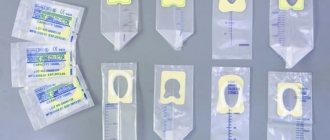Description of the disease
Cystitis is one of the most common pathologies of the genitourinary system in childhood, which is characterized by an inflammatory process occurring in the bladder.
The main symptoms of the disease include: pain and pain when urinating, frequent urges, and bloody discharge in the urine. Cystitis brings great discomfort to the child, making it difficult to lead a normal lifestyle. The main reason for the development of the disease is the penetration of pathogenic microorganisms into the urinary tract, causing inflammation in the bladder. It is noteworthy that girls suffer from this pathology much more often than boys. This is due to the physiological characteristics of the female body (shorter and wider urination channel, proximity to the urethra, vagina and anus).
If you suspect that a child is developing cystitis, you should promptly seek medical advice from a urologist. If left untreated, the disease can cause serious complications and lead to pyelonephritis, urethritis, vesicoureteral reflux, etc.
Symptoms of cystitis
Manifestations of cystitis and their intensity may vary depending on the type of infectious agent that caused the disease, as well as the presence of concomitant inflammatory processes in the body. The most characteristic symptoms of cystitis:
- Frequent urge to go to the toilet “in a small way” (the urge may occur every 20-30 minutes).
- Burning in the urethral area.
- Pain and pain when passing urine.
- Small amounts of urine released when urinating.
- Pain syndrome in the lower abdomen.
- Change in the color of urine (dark, cloudy urine, often with flaky or bloody impurities, sediment).
- Strong unpleasant odor of urine.
- Increased body temperature.
- Weakness, headache.
In infants, pathology can be suspected by restless behavior, crying during urination, sleep disturbances, refusal to eat, and increased body temperature.
Causes of cystitis
In most cases, bladder inflammation occurs under the influence of bacterial flora.
The disease is caused by Escherichia coli, staphylococcus, Klebsiella, chlamydia, Pseudomonas aeruginosa, or combinations thereof. Cystitis can be a primary disease, or it can develop against the background of infectious lesions of nearby organs. In addition, acute and chronic forms of pathology are distinguished. Acute cystitis occurs suddenly and has a rapid course. The following factors can lead to the development of an acute form of the disease:
- Weakening of the child’s immune system caused by hypothermia, vitamin deficiency, chronic diseases, stress, physical or emotional fatigue.
- Failure to comply with the rules of personal hygiene - untimely change of underwear, use of dirty towels, improper washing (it is necessary to wash from front to back, in order not to transfer the infection from the anus to the genitals and urethra).
- Constantly wearing diapers and not changing them in a timely manner.
- The presence of concomitant gynecological diseases (vulvovaginitis, vulvitis).
- Infection with sexually transmitted microorganisms (relevant for adolescents who have become sexually active).
- Catheterization and surgical interventions on the genitourinary system.
The most common reason for the development of chronic cystitis is improper treatment of the acute form or its complete absence.
Lower urinary tract infections in children: options and clinical recommendations
31.07.2020
5509
1
K.I. Kramareva
Pediatric urologist-andrologist of the State Budgetary Healthcare Institution of the Children's Hospital 133 of the Department of Health, chief freelance specialist in pediatric urology-andrology of the Northern Administrative Okrug, Moscow
In the program “An Hour with a Leading Urologist,” Victoria Anatolyevna Shaderkina’s guest was Ksenia Ilyinichna Kramareva, a pediatric urologist-andrologist at the State Budgetary Healthcare Institution of the Children’s City Hospital 133 DZM, the chief freelance specialist in pediatric urology-andrology of the Northern Administrative District of Moscow. She spoke about the features of treating urinary tract infections (UTIs) and, in particular, cystitis in children.
Urinary infections occur in children of both sexes and are a common reason for visiting a pediatric urologist or pediatrician. Bacteriuria is an increase in the number of bacteria in the urinary tract (more than 105 CFU/ml), which can lead to the development of an inflammatory process.
Its main pathogens are Escherichia coli, Klebsiella pneumoniae, Proteus mirabilis, Staphylococcus epidermidis and Enterococcus faecalis. At the same time, the etiological spectrum of pathogens of acute uncomplicated infections of the upper and lower urinary tracts (pyelonephritis and cystitis) is similar. The dominant pathogen is E. coli, which accounts for 70–95% of disease cases. In 5–19%, coagulase-negative staphylococci are isolated, the main sample being Staphylococcus saprophyticus. In other cases, the pathogens may be other enterobacteria (Proteus mirabilis, Klebsiella spp.) and enterococci (Enterococcus faecalis).
Urinary tract infections in children, as well as in adults, include cystitis, urethritis, acute and chronic pyelonephritis, as well as urosepsis.
Cystitis is an infectious and inflammatory disease of the bladder wall of bacterial origin. Girls get it three times more often than boys, and the relative risk of relapse increases with age.
On average, relapses occur in 30% of girls within one year of the first episode and in 50% within five years of the first episode. In boys, relapses occur in 15–20% within one year of the first episode.
There are a number of risk factors for the development of cystitis:
- a decrease in the body’s overall resistance due to hypovitaminosis, stress, hypothermia or changes in hormonal levels during puberty;
- obstruction of urine flow from the bladder (for example, posterior urethral valve);
- circulatory disorders of the pelvic organs;
- traumatic injuries to the bladder mucosa during endoscopic examinations and operations;
- endocrine diseases (diabetes mellitus), metabolic disorders;
- sexual activity, especially early, and in the presence of hypermobility or ectopic urethra in females;
- the presence of allergic reactions (including to personal hygiene products - shower gels, soap, etc.);
- congenital anatomical and structural changes.
Cystitis in children can be classified according to the ways the infection enters the bladder:
- ascending - the most common variant of infection from the external environment through the urethra. A variant of this path is the contact path - in the presence of inflammatory diseases of the organs surrounding the bladder. Direct infection of the bladder can occur in the presence of urinary fistulas or be a consequence of various instrumental manipulations (catheterization of the bladder, cystoscopy, etc.).
- descending – infection from the upper urinary tract and kidneys in chronic pyelonephritis;
- hematogenous - rare, can occur in the presence of a distant focus of chronic infection, including in the pelvic organs.
Another type of classification is according to the clinical course: acute, recurrent and interstitial. Cystitis is also divided according to the involvement of the bladder in the pathological process: primary and secondary (due to some disease).
Due to the development of the disease, cystitis is divided into infectious, allergic, chemical and radiation. According to the type of infectious agent - nonspecific (caused by its own opportunistic microflora) and specific (chlamydia, mycoplasma, ureaplasma, tuberculosis, candidiasis, etc.).
Acute cystitis in children is characterized by a sudden onset caused by some provoking factor. The severity of symptoms increases during the first two days, and in the case of timely prescribed therapy, rapid regression is observed. The most common symptoms of acute cystitis are frequent painful urination, pain in the lower abdomen, the appearance of blood at the end of urination, imperative urge to urinate and associated urge urinary incontinence. Sometimes there may be pain in the lower abdomen and back, as well as fever and chills. The difficulty of diagnosis in young children lies in the difficulty of interpreting symptoms.
In a recurrent course, the manifestation of symptoms of the disease is observed at least twice in six months or three times in a year. The reasons may be reinfection, interrupted or incorrect treatment, uncontrolled use of antibiotics and failure to comply with personal hygiene rules.
Recurrent cystitis in children is a consequence of a previous inflammatory disease and is secondary. Clinical symptoms are similar to those of acute cystitis. A variant of the course is possible with minimal complaints and constant laboratory signs (leukocyturia, bacteriuria), with the absence of hyperthermia.
The main points for diagnosing cystitis are a thorough history taking, especially in young children, and an active conversation with parents or legal representatives. There are no templates for conversations with a child or his family - everything is very individual. When talking with older children, it is necessary to obtain information about possible sexual contacts. Laboratory methods include urinalysis, sterility culture, and ultrasound examination of the urinary tract.
When performing a general urine test, leukocyturia, bacteriuria, erythrocyturia, the presence of epithelium and casts can be detected. False proteinuria is also possible, caused by the breakdown of a large number of blood cells.
If there is a suspicion of an inflammatory process in the urinary organs, a recurrent course of the disease or asymptomatic bacteriuria in the presence of complaints, bacterial urine culture is prescribed to determine sensitivity to antibiotics. It is important both for directly determining the sensitivity of pathogenic microflora to antibiotics and for monitoring the effectiveness of antibacterial treatment.
When prescribing an ultrasound examination of the urinary tract, it is important to remember that changes in the bladder on ultrasound are not specific and must be confirmed by the clinical picture and laboratory data.
In all cases, especially in young children, it is necessary to carry out a differential diagnosis of acute cystitis with acute pyelonephritis. Thus, with cystitis, the temperature rarely rises above 38 ° C, and there may be no symptoms of intoxication and lower back pain, which always accompany acute pyelonephritis. At the same time, with cystitis there is always dysuria, often hematuria. Pyelonephritis is also characterized by changes in blood tests.
Also, in some cases, differential diagnosis with neurogenic bladder dysfunction, vulvovaginitis and dysmetabolic nephropathy is required. We should not forget that these diseases can be present in parallel with cystitis.
The key points in the treatment of cystitis in children are the elimination of symptoms and bacteriuria in the acute period, the prevention of the development of scar changes in the bladder wall, as well as the prevention of relapses.
Ksenia Ilyinichna identified several basic elements for the treatment of cystitis:
- diet (first of all, exclusion of spicy and salty foods, spices, preservatives, smoked foods);
- compliance with the drinking regime (water, cranberry juice, weak tea, exclusion of concentrated juices and any carbonated drinks);
- compliance with the urination regime (the bladder should not be overfilled);
- antibiotic therapy (elimination of pathogens);
- herbal medicine (complex therapeutic effects).
According to the treatment algorithm for uncomplicated cystitis, fosfomycin trometamol (from 5 years of age) and nitrofurantoin are empirically prescribed. Repeated examinations are carried out after 3 days and 12 weeks.
If ineffective, urine culture is performed and therapy is adjusted. However, it should be remembered that even with successful treatment, further prevention of relapse is necessary. In particular, for this purpose, after reducing the severity of symptoms, herbal medicine is prescribed.
A longer course of antibiotic therapy is indicated for the treatment of cystitis in patients with risk factors for recurrent and chronic infection. These include cases of clinical symptoms persisting for more than seven days, as well as the presence of diabetes mellitus and other metabolic disorders in patients.
In recent years, there have been clear trends in increasing resistance of uropathogenic E. Coli strains to antibacterial drugs that are traditionally widely prescribed for community-acquired urinary tract infections: ampicillin (resistance > 30%) and co-trimoxazole (resistance 20-30%). The lowest level of E. Coli resistance is observed to gentamicin and fosfomycin.
Speaking about the treatment of cystitis, it is necessary to note the therapeutic possibilities of using non-antibacterial drugs as part of complex therapy. Thus, in 2015, the World Health Organization published a Global Action Plan on Antimicrobial Resistance, which significantly contributed to the growing interest of the scientific community in the use of non-antibiotic methods for the treatment and prevention of recurrent urinary tract infections, including the use of D-mannose, probiotics and biologically active substances contained in cranberry fruits.
In particular, D-mannose is a non-metabolizable monosaccharide, an isomer of glucose. It has selective activity against pathogenic strains of E. Coli. By binding E. coli receptors, D-mannose prevents their attachment to the epithelium. Analysis of the results of clinical studies made it possible to include D-mannose for the prevention of recurrent UTIs in the Russian recommendations for their treatment for 2021.
Cranberries contain proanthocyanidins A and B, substances that provide their red color. In addition, proanthocyanidins A have an important property - they do not allow bacteria to attach to the walls of the bladder. The European Association of Urology recommends taking 36 mg of cranberry proanthocyanidins per day to prevent cystitis.
Vitamin C creates an acidic environment in the bladder. This is an important part of the fight against bacteria, since they require an alkaline environment to live and reproduce. The vitamin is an antioxidant, which means that it reduces the effects of inflammation in bladder cells and promotes rapid healing and restoration of its walls.
The listed substances can be used as part of phytotherapeutic preparations. In particular, all three mentioned components contain the drug Cystenium II. When included in a complex therapy regimen for recurrent cystitis, it reduces the likelihood of relapses and increases the effectiveness of antibacterial treatment. At the same time, the plant components do not cause resistance in bacteria, so the effectiveness of the drug does not decrease with frequent use. The drug can be used in complex therapy together with antibiotics, a course, and also for prophylaxis during the appearance of factors provoking cystitis. Cystenium II is approved for use in pregnant women and children over 7 years of age. It is taken 1 tablet 1-2 times a day with meals. One dose of the drug should be planned for the evening, since at night there is stagnation of urine and a favorable environment for the proliferation of microorganisms arises. As Ksenia Ilyinichna emphasized, only this drug, among other products in the same category, contains all three active components.
Non-medicinal prevention of cystitis is also important: avoiding hypothermia, maintaining personal hygiene, regularly visiting the toilet and treating foci of chronic infection in the body.
The material was prepared by V.A. Shaderkin's performance can be viewed on Uro. TV in the “An Hour with a Leading Urologist” section
Comments
Oreshkov Vasily Sergeevich - 08/05/2020 - 10:24:14
Thank you very much
To post comments you must log in or register
Diagnosis of cystitis
An important component of successful treatment of cystitis is its timely diagnosis.
In order for the disease to be detected in early, easily curable stages, parents need to show the child to the doctor at the first symptoms of the disease - frequent urination and discomfort in the groin area. Boys and girls with suspected cystitis should be examined by a urologist. Often in girls, cystitis occurs in conjunction with inflammatory processes in the genital organs, which may require additional examination by a gynecologist. During a medical appointment, specialists clarify the symptoms of the disease, their duration and severity in children and their parents. After making a preliminary diagnosis, young patients are referred to laboratory methods for diagnosing the disease:
- general blood analysis;
- general urine analysis;
- bacteriological urine culture;
- urine test according to Nechiporenko;
- microflora smear.
For frequent relapses of the disease, experts recommend performing an ultrasound of the genitourinary system, cystoscopy and cystography. Comprehensive diagnostics is aimed at identifying cystitis and accompanying pathologies (for example, the presence of stone formations in the bladder, damage to the walls of the organ and its deformation).
Correct diagnosis
It is impossible to assess the situation and condition of the baby visually and during examination. You definitely need to take tests and undergo hardware examination. The set of diagnostic measures includes the following procedures:
- Analysis of urine . It is important to correctly collect biological material so that the results are reliable. You definitely need to wash the baby and use special urine bags and a sterile container for collection. The biomaterial should be stored for no more than 2 hours in the refrigerator. The best option is to go to the clinic immediately after taking the test. A urine test is one of the most informative; based on the data, possible inflammatory processes and infectious pathogens are determined.
- Urine culture; in girls, vaginal smear.
- Blood analysis . Necessary to check the general condition of the body, to exclude complications from other organs.
- Ultrasound . Not only the bladder is visible, but also the rest of the pelvic organs.
- Cystoscopy . For small patients, this procedure is carried out only under anesthesia, since a special device is inserted through the urethra. Cystoscopy allows you to visually assess the condition of the bladder tissue, examine the structure and localization of inflammatory foci. Prescribed in complex or too advanced cases.
Timely and correct diagnosis helps to identify the disease in the early stages, select the right treatment, which can alleviate the baby’s condition in the shortest possible time and prevent complications.
Treatment of cystitis
Since in the vast majority of cases cystitis is of bacterial origin, the main method of treatment is antibiotic therapy.
In this case, the type of antibiotic and its dosage should be selected exclusively by a qualified doctor. Excessive independence of parents can lead to irreversible consequences. In addition to a course of antibiotics, the child may be prescribed the following groups of medications:
- anti-inflammatory drugs;
- antifungal drugs;
- antispasmodics;
- antipyretics;
- drugs with a diuretic effect.
To consolidate the therapeutic effect, physiotherapeutic procedures can be carried out: electrophoresis, magnetic therapy, ultra-high frequency therapy, physical therapy.
In addition to the main treatment, patients must follow a special diet and drinking regimen. To combat infectious intoxication, you should drink large amounts of clean drinking water. In addition, spicy, highly salted, smoked and fried foods, as well as carbonated drinks, should be excluded from the children's diet.
Treatment
Treatment of cystitis in children depends on the cause that caused it. Otherwise, improper treatment can lead to serious complications. Antimicrobial drugs are usually prescribed. If therapeutic measures are ineffective, cystitis is treated with antibiotics (after passing a culture test). For the entire duration of treatment, the child is recommended to drink plenty of fluids and adjust his diet, limiting fried, salty, spicy foods. The consumption of yoghurt, milk porridge, lean meats, and fruits is encouraged. This will reduce the inflammatory process and quickly remove the source of infection from the body. In some cases of cystitis in children, they are prescribed physiotherapy for the suprapubic zone, electrophoresis, microwave, and THF. Taking vitamin supplements is also strongly recommended.
Prevention of cystitis
It is much easier to prevent the development of a disease than to subsequently treat it. In order to prevent the occurrence of cystitis, it is important to follow preventive measures:
- Monitor the hygiene of the genital organs: carry out daily washing (in this case, girls need to wash from front to back);
- do not use other people’s things and personal items;
- Buy your child loose, slightly tight underwear made from natural fabrics.
If cystitis occurs, the child should be shown to an experienced specialist. The SM-Doctor clinic for children and adolescents employs qualified doctors who can quickly and effectively eliminate the cause and manifestations of cystitis. Trust the health of your children to professionals!








